
Classification
| Palaeos: |  |
Brachiopoda |
| Brachiopoda | Brachiopod Classification |
| Page Back | Page Up | Unit Home | Metazoa |
| Page Next | Page Down | Dendrogram | Glossary |
The brachiopods have for a long time been
traditionally divided into two classes,
the Inarticulata
and the Articulata.
The Inarticulata are so-called because they possess two valves that do
not have an articulating hinge. Recently it has been suggested that
hinge articulation is not a good way to classify brachiopods anyway, that
![]() the
traditional organization of the Brachiopoda is erroneous, and
that the "Inarticulata" is
probably an artificial group and should perhaps be broken up into several
classes. Cladistic
analysis of the Brachiopoda has resulted in a major revision of the
supra-ordinal taxa of the Brachiopoda, which has become widely accepted,
although the traditional classification as used in the
the
traditional organization of the Brachiopoda is erroneous, and
that the "Inarticulata" is
probably an artificial group and should perhaps be broken up into several
classes. Cladistic
analysis of the Brachiopoda has resulted in a major revision of the
supra-ordinal taxa of the Brachiopoda, which has become widely accepted,
although the traditional classification as used in the ![]() Treatise
on Invertebrate Paleontology, is still standard.
Treatise
on Invertebrate Paleontology, is still standard.
The taxonomy of brachiopods is complicated by homeomorphy,
or similarity due to convergent evolution. In any case newer cladistically-based
arrangements (see ![]() Brachiopod
Systematics and
Brachiopod
Systematics and ![]() Classification
des Brachiopoda) give a much more complex classification arrangement
than the familiar
Classification
des Brachiopoda) give a much more complex classification arrangement
than the familiar ![]() Treatise
on Invertebrate Paleontology, with a large number of higher taxa.
These are compared in the following table:
Treatise
on Invertebrate Paleontology, with a large number of higher taxa.
These are compared in the following table:
|
|
|
Class InarticulataLINGULIDA Linguloidea Trimerellacea ACROTRETIDA Acrotretidina Craniidina PATERINIDA OBOLELLIDA KUTORGINIDA |
LINGULIFORMEALingulataLINGULIDALinguloidea Discinoidea Acrotheloidea ACROTRETIDA SIPHONOTRETIDA PaterinataPATERINIDACRANIIFORMEACraniataCRANIOPSIDACRANIIDA TRIMERELLIDA RhynchonelliformeaChileataCHILEIDADICTYONELLIDA ObolellataOBOLELLIDANAUKATIDA KutorginataKUTORGINIDA |
Class ArticulataORTHIDA Orthodina Triplesiidina Clitambonitidina ORDER UNCERTAIN Dictyonellidina STROPHOMENIDA Strophomenidina Chonetidina Productidina Oldhamadina PENTAMERIDA Syntrophiidina Pentameridina RHYNCHONELLIDA SPIRIFERIDA Atrypidina Retziidina Athyrididina Spriferidina TEREBRATULIDA Centronellidina Terebratulidina Terebratellidina ORDER UNCERTAIN Thecideidina |
StrophomenataSTROPHOMENIDAPRODUCTIDA Chonetidina Productidina Strophalosiidina Lyttoniidina ORTHOTETIDA Orthotetidina Triplesiidina BILLINGSELLIDA Billingsellidina Clitambonitidina RhynchonellataPROTORTHIDAORTHIDA Orthodina Dalmanellidina PENTAMERIDA Syntrophiidina Pentameridina RHYNCHONELLIDA ATRYPIDA Zygospiridina Atrypidina Lissatrypidina Davidsoniidina ATHYRIDIDA Athyrididina Retziidina Koninckinidina SPIRIFERIDA Spriferidina Delthyridina SPIRIFERINIDA Cyrtinidina THECIDEIDA Thecideidina TEREBRATULIDA Centronellidina Terebratulidina Terebratellidina |
It seems to me that this newer version, based as it is on Cladistics, gives a grossly inflated number of higher Linnaean taxa for the "Inarticulates". What was previously a simple class is now divided into no less than three subphylum and six classes! To give the idea of a subphylum, the entire Vertebrata (Vertebrate animals) are in the Linnaean arrangement a subphylum of the phylum Chordata. The taxonomic diversity of a very morphologically conservative group like the "Inarticulates" certainly does not seem to justify such a high ranking. This is typical of the sort of problems that come about when trying to integrate Cladistic and Linnaean systems. Such attempts often lead to a huge taxonomic inflation of ancestral ("basal") taxa.
The Articulates meanwhile are in the newer arrangement split into two classes and a greater number of orders, some of which may indeed be warranted (for example four rather one order of "Spirifid" brachiopods can be justified if it can be shown that the Spirifid condition evolved in four different and unrelated lineages).
The relationship of the Phoronida (burrowing worm-like lophophorates) is another problem. Although a number of authors still regard Phoronida as constituting a separate phylum. Several recent evolution trees show the Phoronida and Brachiopoda as closely interrelated, with the Brachiopoda possibly a paraphyletic group. It is becoming increasingly accepted that the constitute a single clade together with the Brachiopoda, possibly as a class within the phylum Lophophorata, which also includes the Bryozoa, and Brachiopoda, all three groups sharing a ciliated lophophore and a number of other features (although the status of the Bryozoa awaits molecular confirmation).
It has even been suggested that brachiopods are polyphyletic, and that is, that different brachiopod groups evolved separately from soft-bodied phoronid-like ancestors.
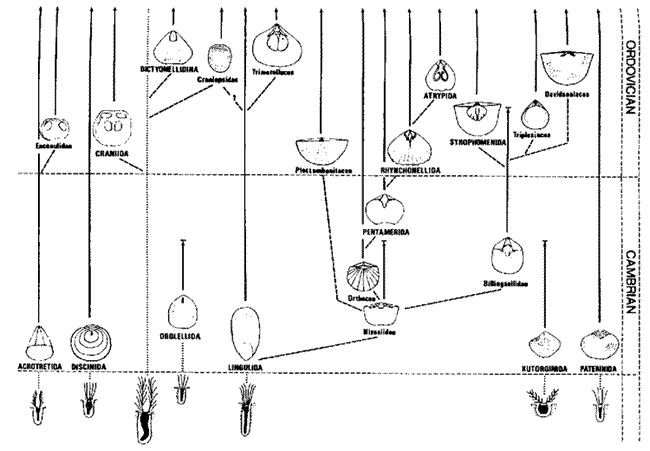
This might explain the way in which a number of distinct brachiopod lineages appear in the earliest Cambrian with no intermediate forms.
Note, in the following classification, diagnosis for the most part follows ![]() Sean
Robson
Sean
Robson
|
Linguliform brachiopods with smooth or pitted larval shell; marginal setae form continuous rows along mantle margin; digestive tract recurved with anteriorly placed, functional anus. |
|
|||
 |
 |
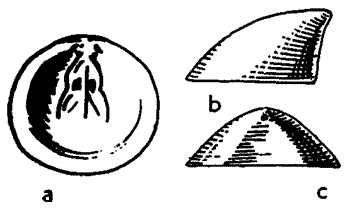 |
 |
 |
|
|
|
|
|
|
|
|
||
 |
image available yet |
image available yet |
|
|
|
|
Brachiopods with calcitic articulated shells. Teeth and sockets are usually present, except in some primitive "inarticulate" forms, but can be lost secondarily. The gut is blind and without an anus. The Articulata have calcareous shells whose valves, like Bivalve mollusk shells, are hinged (articulated) by well-developed teeth and sockets. The shell is divided into two distinct layers, primary (outer) and secondary (inner). The outer layer is lamellar (consisting of layers) and the inner layer is fibrous, made up of calcareous fibers.
|
|
|
|
||
|
image available yet |
image available yet |
 |
image available yet |
 |
|
|
|
|
|
|
|
|
|||
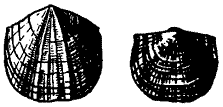 |
 |
 |
 |
|
|
|
|
|
|
|
||||
|
image available yet |
 |
no
|
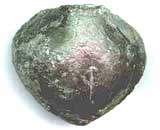 |
no
|
| Protorthida |
|
|
|
|
|
no
|
no
|
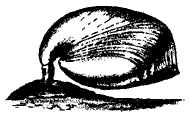 |
no
|
image available yet |
|
|
|
|
|
|
| Links |
![]() Brachiopods - this European Web site includes up-to-date information on Brachiopoda, references,
Brachiopods - this European Web site includes up-to-date information on Brachiopoda, references, ![]() systematics,
diagnoses...) a directory of specialists working on brachiopods (Brachiopodologists
- yes, there is such a term!).
systematics,
diagnoses...) a directory of specialists working on brachiopods (Brachiopodologists
- yes, there is such a term!).
![]() Brachio-Philes
- Sean Robson's Brachiopod site - see his
Brachio-Philes
- Sean Robson's Brachiopod site - see his ![]() Brachiopod
Systematics page
Brachiopod
Systematics page
The classifications on both these sites are based on Williams, Carlson, Brunton, Holmer, and Popov, 1996: A Supra-ordinal classification of the Brachiopoda. Philosophical Transactions of the Royal Society of London. Series B. Volume 351, pgs.1171-1193.

Brachiopoda main page |